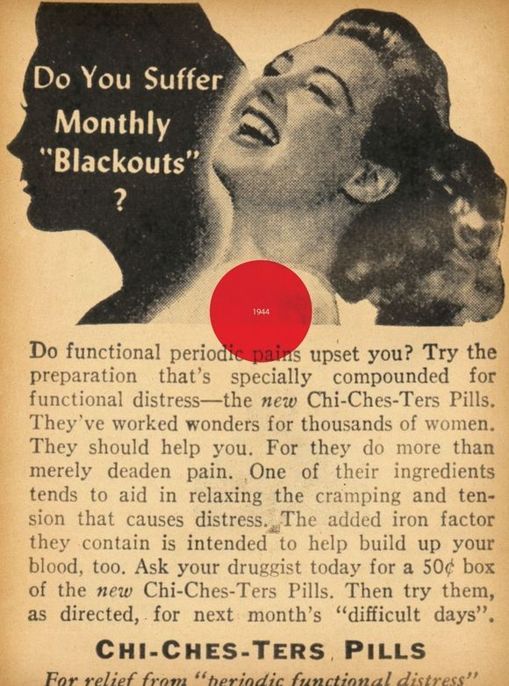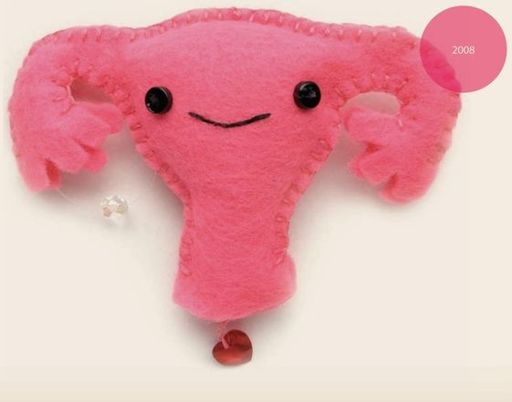Flow: The Cultural Story of Menstruation (33 page)
Read Flow: The Cultural Story of Menstruation Online
Authors: Elissa Stein,Susan Kim
Tags: #Health; Fitness & Dieting, #Women's Health, #General, #History, #Historical Study & Educational Resources, #Politics & Social Sciences, #Women's Studies, #Personal Health, #Social History, #Women in History, #Professional & Technical, #Medical eBooks, #Basic Science, #Physiology

Depending on how one feels about needles, some women swear by acupuncture as an effective way to relieve menstrual symptoms. For those of us more faint of heart, there’s also acupressure and/or reflexology. Assuming one can commandeer the bathroom for an uninterrupted hour, one can also try hydrotherapy in the comfort of one’s own home, soaking peacefully in a warm tub. Alternatively, cramps can often be relieved with hot water bottles or, funnily enough, even ice packs. Massage, especially when focused on the pelvic region and lower back, works for many; we ourselves are especially fond of this treatment, even when we don’t have cramps or aren’t menstruating. In addition, there are numerous homeopathic and ayurvedic remedies one can try.


Tampon Plushie ©Amanda Adams
We hate to be the ones to add yet another reason why one should get off that couch, especially if one is feeling kind of tired and crampy, but the fact remains that exercise is one of the best ways around to deal with menstrual discomfort. We’re not necessarily suggesting springing out the door and into a marathon (although Uta Pippig was visibly bleeding when she won her third consecutive Boston Marathon in 1996). Yet yoga, biking, swimming, dancing, hiking, and rock climbing all release endorphins, the naturally occurring “happy drug” in our brains, which can stop cramps cold. What’s more, increased circulation and blood oxygen levels can help with pelvic discomfort. The same can be said of indoor sports. Menstrual sex may not be to everyone’s liking, but the fact remains that orgasms are an effective, all-natural cramp reliever. Plus, they’re free!
Hands down, however, our favorite loopy therapy available online is special underwear outfitted with various magnets. According to the manufacturer, magnetic therapy reduces menstrual pain and PMS symptoms, although we have yet to be convinced. Nevertheless, we enjoy the image of coming home from work covered with loose paper clips and staples or, better yet, trying to talk one’s way through airport security.
Happy Uterus @ Kristen St. Thomas

Speaking of alternative, there are also interesting things you can do with, believe it or not, your menstrual blood. Did you know one’s flow can be used to fertilize plants? In Her Blood Is Gold, Lara Owen says she routinely soaks her used cloth pads in a covered bucket of cold water and then at the end of the week uses it in her garden. She also recommends bleeding on the ground from time to time, both to reconnect with and fertilize the earth. Rather than view her flow as waste, she instead reinterprets it as a powerful, nurturing substance. Her rationale is that when a woman is pregnant, all that extra blood and rich tissue goes to protecting a growing fetus. So why not put it to good use instead of flushing it down the toilet?
The underlying notion—that there’s something potentially useful about our flow—is not as loopy as it may first sound. In fact, it’s currently being explored by researchers who have recently discovered that menstrual blood contains certain types of stem cells. Potentially, endometrial stem cells could be used to combat a host of diseases and would be arguably less controversial, to some, than those obtained from human embryos.
The importance of menstrual flow was taken to new heights in 1993’s Blood, Bread, and Roses: How Menstruation Changed the World. In her book, author Judy Grahn reinterprets all of history and cultural development from the standpoint that just about everything—from the invention of eating utensils, shoes, and furniture, to the notion of time, the origins of science, and human consciousness itself—somehow arose in direct response to menstruation. While one might certainly find fault with Grahn’s menstrucentric thesis (we ourselves are a tad skeptical, considering that bleeding women have basically been treated like dog poop throughout history), it’s nevertheless a thoughtful and creative attempt to recognize and honor women and their cycles.
There is, in fact, an underground movement of sorts to celebrate the female reproductive cycle and to bring it into the mainstream. Grassroots organizations, alternative workshops, Web sites, books, and zines have sprung up over the last twenty years, trying to creatively and spiritually conquer the shame that’s been ingrained in us for thousands of years.

Hearts and Lady Parts © Erin Seery
Heal the Womb workshops, thrown by the Magick School in London, include such activities as massaging and positioning your own womb, as well as making “heal the womb” charm bags and your own personal goddess menses. One can pick up sacral chakra dancing, learn about herbs and crystals for feminine energy, or even paint one’s belly to celebrate one’s goddess belly.
Red Moon Rites of Passage endeavors “to empower your journey of making peace with your menstrual cycle, inspire you to welcome a girl into womanhood with ease and authenticity, and guide you to deeply appreciate your being a woman.” Their goal is to help women recover from years of anger, frustration, embarrassment, and nonacceptance of their menstrual cycles, so they can then support girls they know from a positive and accepting place. They’ve started a training program for women to develop a closer spiritual relationship with their cycles and to eventually lead their own “coming of age”and“menstrual empowerment” ceremonies.
While Web sites tend to be launched and then wither away like dandelions in springtime, the trend of menstrucentric sites doesn’t seem to be fading. Right now at womanwis-dom. com, one can buy a home-study course with topics including the shamanic power of menstruation, sacred geometry, the wisdom and madness of menstrual taboos, the eroticism of blood mysteries, and menopause as a second puberty. One can also buy a guided meditation CD, goddess gowns in various colors, ceremonial crowns, even a menarche kit containing a jewelry-making project, workbooks, and a DVD.
Pink Uterus ©Claire Elizabeth Platt

When it comes to menarche, we ourselves have not actually participated in but have heard tales of red parties—where the food is red, the presents are red, and everyone wears red—all to celebrate a girl’s first period. Knowing the girls in our lives, we think this could be seen as either a wonderful, empowering event that will be treasured forever or “the most humiliating thing that ever happened to me.”Yet isn’t at least the attempt to inject some celebration into a major life event preferable to the usual cultural hazing ceremony of fear, shame, and ignorance?
I was ten years old. I was on vacation, without my parents, with my cousins in Oklahoma. We were vacationing on a lake—swimming/waterskiing, etc. Even though I knew quite well what a period was and it was normal and nothing to be frightened of, I was horrified! I didn’t tell my aunt or anyone else and I kept making excuses why I wouldn’t go in the water. I kept stuffing toilet paper in my underwear. Finally, my aunt found out and of course helped me and called my mom, who I also spoke to. I felt much better once everyone knew and helped me. When I got home, my mom bought me a beautiful turquoise and silver ring to commemorate the occasion. I love that ring!
—Sarah B. (44)
And how much more celebration can one imagine than 105 Ways to Celebrate Menstruation? In her book, herbalist Kami McBride encourages women to acknowledge and appreciate monthly changes and cycles, instead of sweeping them perfunctorily under the rug while pretending they’re not happening.
In 2007, the environmentally friendly company Seventh Generation launched
tampontification.com
, on which people could “virtually” donate femcare supplies to homeless shelters: each click would send a package of chlorine-free pads and tampons to women in need. The link went viral, as thousands of women forwarded it to their friends, families, and coworkers (we know we did); overwhelmed by the extraordinary response, Seventh Generation had to suspend the program until further notice.
There are so many menstrual-related Web sites, products, workshops, and support groups online, it’s hard to keep track of them all. One can buy menstrual art that’s been painted with actual blood. One can read about cultural rituals in which menstrual blood is used to attract men or keep them faithful. One can be even fringier and check out Web sites for those interested in “vampire play,” where it’s suggested that imbibing menstrual blood is an easy and painless way to quench one’s thirst. One can read about how the act of performing oral sex on a menstruating woman is called getting one’s “red wings.” And for those interested in even kinkier stuff, one can check out
eroticred.com
, which features “homemade sexy, natural, & fun menstruation porn created by a variety of hot models of all shapes and styles on their periods!” There’s even the Menstrual Avenger, an online cartoon heroine who can be found fighting evil with nothing more than a tampon lasso, a flying pad, and (when all else fails) her powerful, fire-hydrant-esque flow.
Femcare has been so long monopolized by manufacturing medicine, advertising, and religion that any fresh, individual voices seem like cool water in a blazing desert.
We couldn’t write a book about menstruation without mentioning the Museum of Menstruation, an online treasure trove of menstrual history, information, and artifacts created and run by Harry Finley. For four years, the museum was housed in the basement of his suburban Washington, D.C., house (one of us recalls walking down his steep, slightly spooky basement steps and finding female mannequin torsos, decked out in historical menstrual gear, disconcertingly hanging from the ceiling), but now it exists strictly in cyberspace, at
mum.org
.
